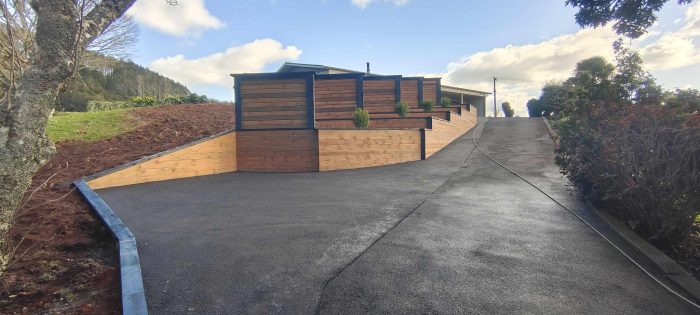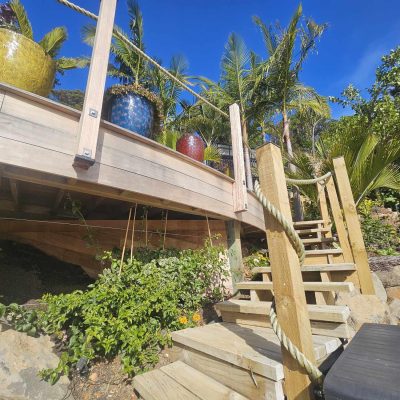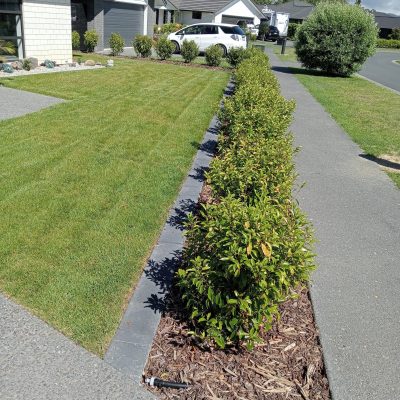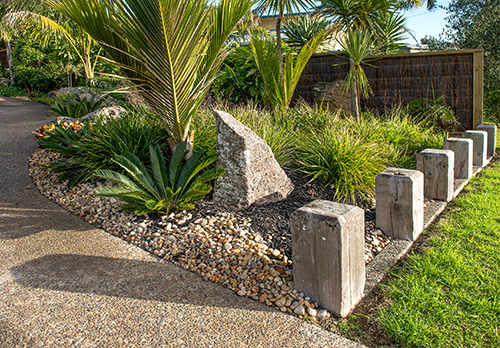Landscaping involves transforming outdoor spaces into functional and aesthetically pleasing areas. Achieving a harmonious and inviting environment often requires a careful balance of two key components: hard and soft landscaping.
Hard landscaping encompasses the structural elements of a space, while soft landscaping focuses on living materials. Both play vital roles in creating outdoor areas that are both practical and beautiful.
Let’s explore the differences between these two approaches and how they complement each other.
Hard Landscaping
 Hard landscaping refers to the structural, non-plant elements within a garden or outdoor space. These are typically man-made features constructed from materials such as stone, concrete, wood, and metal.
Hard landscaping refers to the structural, non-plant elements within a garden or outdoor space. These are typically man-made features constructed from materials such as stone, concrete, wood, and metal.
Materials and Design
The choice of materials for hard landscaping can significantly impact the overall look and feel of a space. Hard landscaping trends don’t have to break the bank.
- Stone: Offers durability, natural beauty, and a wide range of styles, from classic to contemporary.
- Concrete: Versatile and affordable, allowing for various finishes and patterns.
- Wood: Adds warmth and natural charm, but requires regular maintenance.
- Metal: Provides a modern and sleek appearance, often used for accents or contemporary designs.
Design styles for hard landscaping vary widely. Popular options include:
- Formal: Characterised by symmetry, clean lines, and geometric shapes.
- Informal: Emphasises natural curves, asymmetry, and a relaxed atmosphere.
- Modern: Focuses on minimalist aesthetics, clean lines, and innovative materials.
- Traditional: Incorporates classic elements and historical influences.
Purpose and Function
Beyond aesthetics, hard landscaping serves several practical purposes:
- Defining Spaces: Creating distinct areas within a garden, such as patios, walkways, and seating areas.
- Improving Drainage: Preventing water logging and erosion through features like retaining walls and drainage channels.
- Providing Accessibility: Ensuring easy movement around the garden with well-designed paths and ramps.
- Creating Focal Points: Drawing attention to specific areas with striking hardscape features.
Maintenance
While hard landscaping is generally low-maintenance compared to soft landscaping, it still requires some care. Regular cleaning, sealing, and repairs can help maintain the appearance and longevity of these features.
Hard Landscaping examples
Soft Landscaping

Soft landscaping involves the use of living, organic materials to create a natural and visually appealing outdoor space. Plants, flowers, grasses, and trees are the core components of soft landscaping, providing colour, texture, and life to a garden.
Plant Selection
Choosing the right plants for your garden is crucial for its success. Consider the following factors:
- Climate: Select plants that are well-suited to your local climate, ensuring they can thrive in your conditions.
- Soil Type: Different plants have varying soil requirements. Choose plants that match the soil conditions in your garden.
- Sunlight: Determine the amount of sunlight your garden receives and select plants accordingly.
- Space: Consider the available space and choose plants that will grow to appropriate sizes.
- Purpose: Determine the desired function of the plants, whether it’s for color, shade, privacy, or wildlife attraction.
Sustainable Landscaping
Sustainable landscaping practices are becoming increasingly important. By incorporating eco-friendly approaches, you can create a garden that benefits both people and the environment.
- Water Conservation: Choose drought-tolerant plants and implement water-saving irrigation systems.
- Native Plants: Prioritise native plants as they are well-adapted to local conditions and support wildlife.
- Organic Practices: Avoid harmful chemicals and opt for organic fertilisers and pest control methods.
- Reduce Lawn Area: Consider replacing some of your lawn with low-maintenance ground covers or native plants.
- Composting: Recycle garden waste by creating a compost pile to enrich your soil.
Soft Landscaping examples
Complementary Nature
 Hard and soft landscaping are two sides of the same coin, working in harmony to create beautiful and functional outdoor spaces. The interplay between these elements is essential for achieving a balanced and visually appealing garden.
Hard and soft landscaping are two sides of the same coin, working in harmony to create beautiful and functional outdoor spaces. The interplay between these elements is essential for achieving a balanced and visually appealing garden.
Creating Harmony and Contrast
The successful integration of hard and soft landscaping involves creating a harmonious balance between the two. However, contrast can also be a powerful tool.
- Softening Hard Edges: Plants can soften the harsh lines of patios, walls, and other hard landscaping features. For example, trailing vines or groundcovers can be used to soften the appearance of a concrete wall.
- Highlighting Architectural Elements: Plants can be used to draw attention to specific architectural features. For instance, a tall tree can accentuate the height of a building or a flowering climber can enhance the beauty of a pergola.
- Creating Focal Points: Combining hard and soft landscaping elements can create striking focal points in the garden. A water feature surrounded by colourful plants or a sculpture placed on a stone patio are examples of this.
- Playing with Textures: The contrast between the smooth surfaces of hardscape materials and the varied textures of plants can add depth and interest to a garden.
Practical Considerations
Beyond aesthetics, the combination of hard and soft landscaping offers practical benefits:
- Improving Drainage: Plants can help to absorb excess water, reducing the risk of waterlogging.
- Reducing Erosion: Groundcover and plants can help to stabilise soil and prevent erosion on slopes.
- Providing Shade: Trees and shrubs can offer shade on hot days, creating comfortable outdoor living spaces.
- Creating Privacy: Tall hedges or strategically placed plants can provide privacy and seclusion.
By carefully considering the relationship between hard and soft landscaping elements, it’s possible to create outdoor spaces that are both visually stunning and functional.
Hard and Soft Landscaping examples working together
Conclusion
Hard and soft landscaping are two distinct yet complementary approaches to garden design. Hard landscaping provides the structural framework, while soft landscaping adds life and beauty.
By carefully balancing these elements, it’s possible to create outdoor spaces that are not only visually appealing but also functional and sustainable. Whether it’s a small courtyard or a sprawling garden, a well-designed combination of hard and soft landscaping can transform any outdoor area into a haven for relaxation and enjoyment.


















